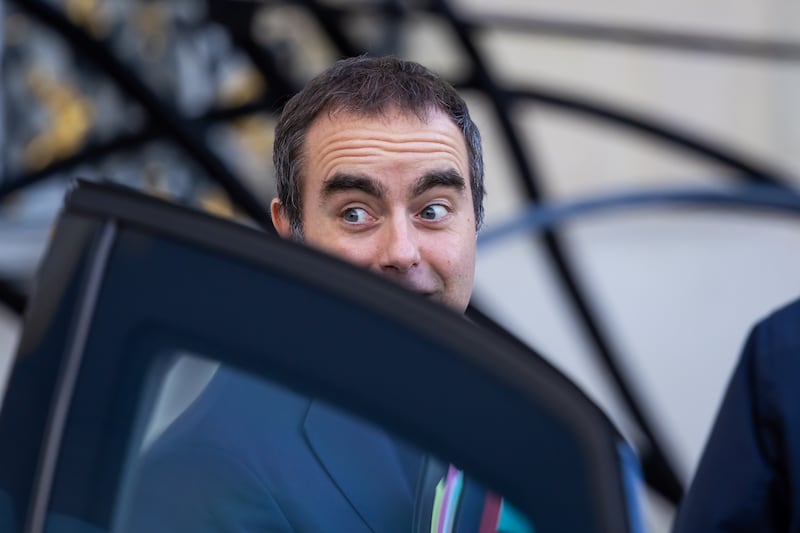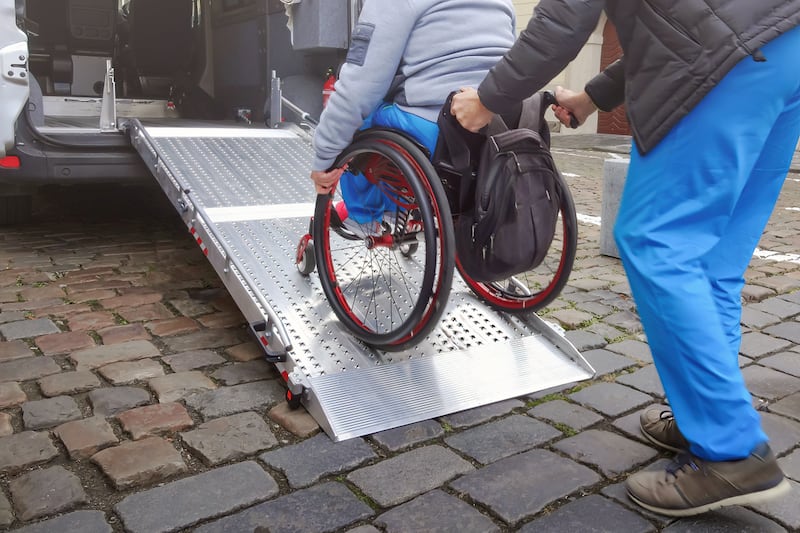Across north Dublin, mounting excitement about the Valentine’s disco and dance competition at the Stardust on Friday, February 13th, had young people in a whirl of giddy anticipation.
“I remember the build-up for weeks,” said Antoinette Keegan. “We were all looking forward to the big night out. It was fantastic.”
Her recollections came at fresh inquests into the deaths of 48 people in a fire at the nightclub later that night in 1981.
Her sisters Martina and Mary and several friends were among those who lost their lives in the inferno.
READ MORE

The Stardust, on the Kilmore Road in Artane which opened in March 1978, was the most exciting nightclub and cabaret venue on the northside. With its large stage, five bars, function room and capacity for more than 1,400 people, it hosted showband stars such as Joe Dolan and Dickie Rock as well as major British acts such as Cliff Richard, Ian Dury and The Blockheads, The Specials and Showaddywaddy.
The venue was always busy, overcrowded even, and on that Friday huge numbers of young people were expected. The night was to be sponsored by international record label K-tel, the disco-dance competition overseen by five DJs, and a bar extension had been granted until 1am.
Follow live: Stardust inquests verdicts delivered on deaths of victims in nightclub fire
Shortly after 1.40am, on the morning of February 14th, a small flame was seen on a seat at the back of a partitioned-off area known as the west alcove. It looked controllable. No one who observed it at this point felt themselves to be in danger. Within a minute, however, fire spread to adjoining seats. Two minutes later it was spreading across the ceiling. A minute after that black, toxic smoke billowed and filled the ballroom. And within three further minutes the ceiling began to collapse and flames vented through the roof. Eight minutes after the small flame was first spotted the entire ballroom was engulfed in flames.
The inferno had peaked by 2am, ultimately killing 48 people and seriously injuring more than 200.
The Stardust fire remains the worst, in terms of loss of life and significant injury, in the State’s history.
A tribunal of inquiry was established within days. Tasked with finding a cause for the fire its chair, Mr Justice Ronan Keane, found in 1982 the most “probable” cause was arson. Despite finding “serious shortcomings” in the management of the Stardust, and “manifest failure” to “ensure that the premises were properly and efficiently managed so as to ensure fire safety”, there was never an apology from the owners – the Butterlys – nor any prosecution for their failings.
The Butterly-owned companies that owned the Stardust were awarded almost £600,000 in the Circuit Court in their civil claim for malicious damages against Dublin Corporation, in 1983.
The families of the victims, their grief compounded with the finding that young people of their community had probably started the fire, had to fight for four years for the establishment of a Stardust victims’ compensation tribunal.
They never believed arson caused their loved ones’ deaths.
Some fought for more than four decades demanding to know the truth.
On the direction of the then attorney general Séamus Woulfe in 2019, fresh inquests opened at Dublin Coroner’s Court on April 25th, 2023, sitting for more than 122 days and hearing from 373 witnesses.
On Thursday April 18th 2024, the 12-person jury returned its verdicts, making findings of unlawful killing in all 48 cases.
The 48 who died as a result of the fire in the early hours of St Valentine’s Day were aged between 16 and 27 years. They were cherished sons, daughters, siblings, grandchildren, nieces, nephews, cousins, neighbours, work colleagues and friends. Among them were some families’ only son, only daughter, only child. There were parents, a mother-to-be, a married couple and a husband and father.
They were Michael Barrett (17), Richard Bennett (17), Carol Bissett (18), James Buckley (23), Paula Byrne (19), Caroline Carey (17), John Colgan (21), Jacqueline Croker (18), Liam Dunne (18), Michael Farrell (26), David Flood (18), Thelma Frazer (20), Michael Ffrench (18), Josephine Glen (16), Michael Griffiths (18), Robert Hillick (20), Brian Hobbs (21), Eugene Hogan (24), Murtagh Kavanagh (27), Martina Keegan (16), Mary Keegan (19), Robert Kelly (17), Marie Kennedy (17), Mary Kenny (19), Margaret Kiernan (18), Sandra Lawless (18), Francis Lawlor (25), Maureen Lawlor (23), Paula Lewis (19), Eamonn Loughman (18), George McDermott (18), William McDermott (22), Marcella McDermott (16), Julie McDonnell (20), Teresa McDonnell (16), Gerard McGrath (21), Caroline McHugh (17), Donna Mahon (17), Helena Mangan (22), Jim Millar (20), Susan Morgan (19), David Morton (19), Kathleen Muldoon (19), George O’Connor (17), Brendan O’Meara (23), John Stout (18), Margaret Thornton (19) and Paul Wade (17).
The majority were from the surrounding working-class areas of Coolock, Kilmore, Kilbarrack and Artane but they came too from Ringsend and Sandymount in Dublin; Kells in Co Meath, and from Derry and Belfast.
From its very inception the Stardust was incompetently and inadequately managed, the inquests heard.
It was located in a former jam and food-processing factory. It had been owned by R&W Scott (Ireland) Ltd but was bought by market-gardener Patrick Butterly in 1972. He changed the name of the company to Scotts Foods Ltd.
Originally from Rush, Co Dublin, Butterly worked his way, by sheer graft and wheeling-and-dealing, from relative poverty to relative wealth in the fruit and veg industries. He needed his own factory to process his fruit and veg. With an eye for an opportunity, he decided to convert a portion of the premises into an entertainment venue.
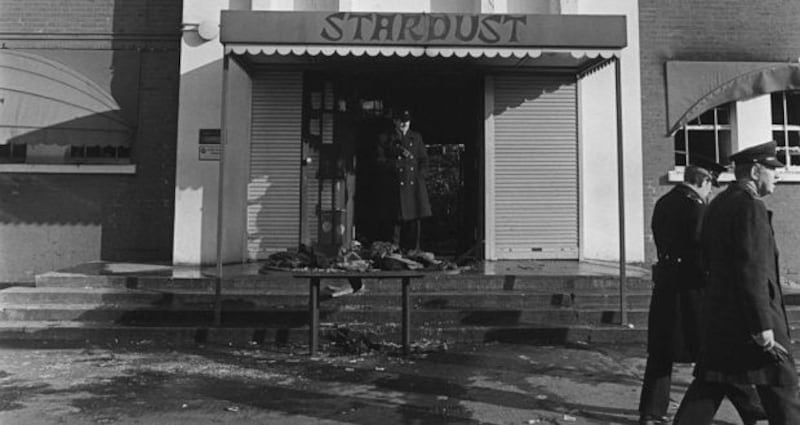
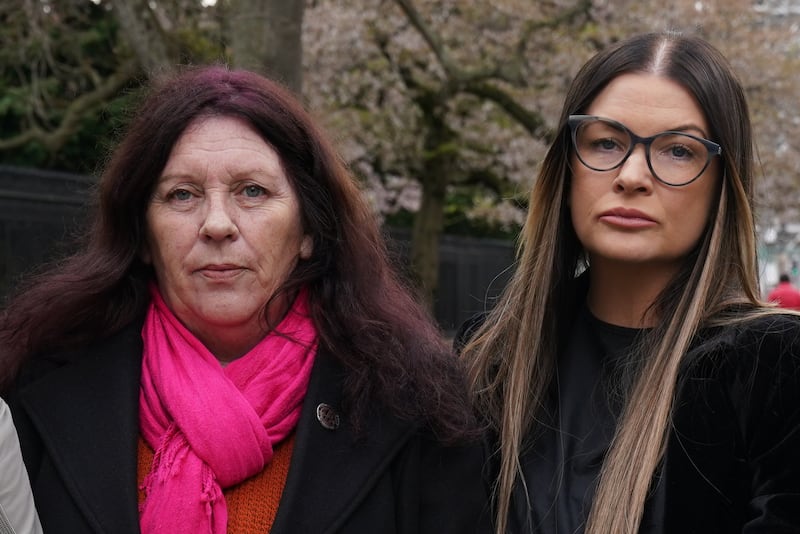
Despite having little experience in such a conversion project, he did not employ a qualified architect, turning instead to a local draughtsman, the late William White, to draw up plans. Dublin Corporation – now Dublin City Council – refused White’s three applications, between February 1976 and January 1977. The late Harold Gardner, also a draughtsman, took over in early 1977 and submitted new drawings seeking approval under building bylaws and bylaws for places of public resort.
Butterly put his eldest son Eamon Butterly, then in his early 30s, in charge of overseeing the conversion. Having left school at 14, Eamon Butterly had been sent to study agriculture, destined to work on the family farm. With no training in construction, architecture or project management, he got to work on the Stardust project in June 1977.
The Butterlys were “all Fianna Fáilers”, wrote Patrick Butterly in his posthumously-published memoir, From Radishes to Riches, and he was a member of the party’s fund-raising machine Taca through the 1970s and 1980s. “What you had these people for was to help get things,” he wrote. “If you wanted someone who could do something . . . you asked these people.”
The corporation replied to Gardner in August 1977, outlining its requirements and noting he should already have the Dublin Fire Brigade (DFB) chief officer’s conditions, particularly that “all internal wall and ceiling linings to have a minimum Class 1 surface spread of flame rating”.
Of 26 bylaws applicable to the Stardust, 16 would be breached, the inquests heard. The most fateful would centre around Eamon Butterly’s decision to line most of the Stardust’s internal walls with almost 3,000 PVC-backed polyester-fibre carpet-tiles rather than Tyrolean plaster as described in the planning drawings. The carpet-tiles, which would be central to the rapid spread of the inferno, were suggested by floor-coverings sales representative Declan Conway.
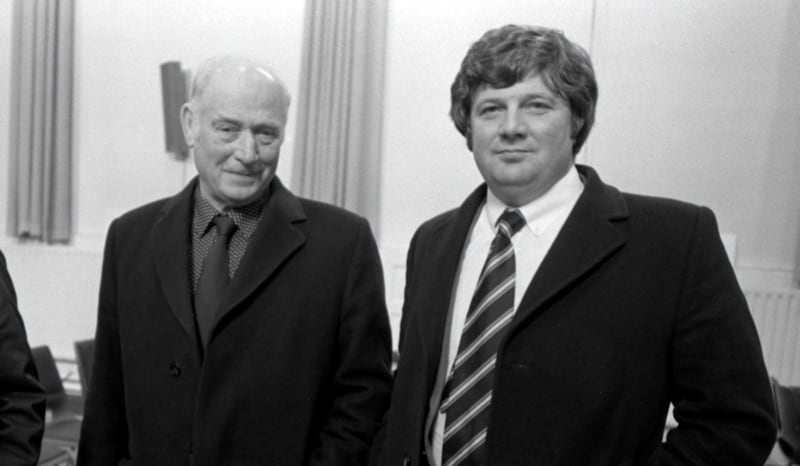
He knew Eamon Butterly was worried about the Stardust’s acoustics. The tiles would improve acoustics and “looked well”. Marketed under the brand Stateroom, they were a deep-red colour, and manufactured by the now-closed Bradford-based company, Illingsworth. They were being phased out by Illingsworth and came at a reduced price.
Conway told the inquests he had obtained a fire certificate, as requested by Eamon Butterly, from Illingsworth, adding Illingsworth knew they would be placed vertically on walls. Illingsworth, however, told the 1981 Keane tribunal of inquiry into the fire it had never produced carpets for use on walls and certainly would not provide fire certificates for their vertical use.
The tiles had a Class 3 or 4 surface spread of flame rating, far below the rating specified by the chief fire officer. How they ended up on the walls remains contested.
When Eamon Butterly appeared at the inquests last September, he insisted it had not been his responsibility to understand what Class 1 surface spread of flame meant. In fact, it wasn’t up to him to know about fire safety or what was needed to ensure the Stardust was safe, he insisted.

Podcast: Why did justice for Stardust victims take so long?
“Safety was paramount but there was nobody at that time to tell you how to make people, the staff [safe], to teach you what you had to do to make the place safe when you were converting it,” he said.
Gardner, who had no fire safety expertise, nonetheless knew regulations existed and had bought Eamon Butterly a copy of the 1934 bylaws on fire safety in relation to “places of public resort”. But Butterly never read them. The 105 bylaws had been drawn up after the 1926 Dromcollogher cinema fire in Co Limerick which had also killed 48 people.
At the inquests Eamon Butterly argued the corporation’s senior planning officer, Dermot King, had seen the tiles going up on the walls during the conversion and made no objection. If the corporation had a problem with the tiles, he argued, they should have told him at the time.
[ ‘Why were our children brought into a fire trap?’: Stardust families seek answersOpens in new window ]
King, now deceased, confirmed in 1981 he had indeed noticed the tiles and known they weren’t planning compliant. But he believed they were a matter for Dublin Fire Brigade. He would have known, however, Dublin Fire Brigade did not inspect buildings during construction unless requested to. This was a crucial “missed opportunity” by the corporation, the inquests heard, though Patricia Dillon, senior counsel for Dublin City Council, countered in closing statements the permission granted in January 1978 had been for plastered walls and no application had been made to change this.
“On the night of this fire the only planning permission that was operative . . . related to the original permission, and compliance . . . required Tyrolean plaster walls,” she said.
As soon as it opened Stardust was packing in large crowds. Patrick Butterly wasn’t happy with profits, however. The venue, which also included the Lantern Rooms restaurant and function room, and the Silver Swan bar, had two separate general managers in a year.
In mid-1979 Patrick Butterly put Eamon Butterly in charge. He had training in neither management, hospitality nor fire-safety.
One of his ideas to boost profits was to put on discos on Friday and Sunday nights, thereby tapping into a huge potential customer base in the new young suburbs around Artane. They began in February 1980.
Eamon Butterly, who hadn’t read the 1934 bylaws, said he didn’t realise his staff should have had fire-safety training. Or that there should have been an emergency evacuation plan; regular fire drills or that chains and locks should have been stored on a central key board when the venue was open. Instead, staff were not trained, there were no drills and chains were left draped over exit panic-bars to make them appear locked.
The Stardust was inspected about 30 times from 1979 by the corporation’s electrical inspector, the late Martin Donohoe. Where he noted bylaw breaches he escalated them. He made numerous reports including nine between July 1979 and January 1981 about exits having chains and locks draped around the panic-bars, exits locked, obstructed or not functioning.
Instead of responding by ensuring doors were kept unlocked and unobstructed, Eamon Butterly sanctioned a plan to keep at least three of the six exits locked until about midnight on disco nights. He suspected young patrons were letting friends in for free through the emergency exits, and in December 1980 he learned some of his own doormen were letting in patrons, charging them less than the cover charge.
His paranoia growing, about three weeks before the fire he had toilet windows sealed shut, with metal sheets welded inside and metal bars outside, to stop “alcohol” and “weapons” being passed in. These measures had been “forced” on him by patrons, he told gardaí in 1981.
Pressure was also building from Dublin Corporation. On January 15th, 1981, British ska band The Specials played the Stardust. The premises was severely overcrowded – one estimate said about 2,000 people were there – and at least one exit was locked and obstructed. On January 23rd, principal planning officer Charles Kelly wrote to Patrick Butterly. “Unless I receive your immediate assurances that exit ways will in future be maintained unobstructed at all times the public are on the premises and immediately available, it will be necessary to institute proceedings against you for contravention of the above bylaws and also to raise the matter during the hearing of your application for renewal of your annual licence,” he warned.
Patrick Butterly handed the letter to Eamon Butterly to deal with. On January 27th Eamon Butterly replied: “I personally take great care to make sure all exits are clear . . . Again, I assure you all exits will be kept clear when the public are on the premises.” The overcrowding had been due to tickets being forged and he would not be holding concerts again, he added.
Just over two weeks later he broke this promise, with catastrophic consequences.
[ Video: A Stardust survivor recounts the night her two sisters died in the blazeOpens in new window ]
In an Ireland blighted by recession and emigration, where the Troubles dominated news and the Catholic Church exerted control over people’s lives, music promised escape, excitement and a taste of freedom.
Places of pilgrimage for Dublin’s huge young population included the Dandelion Market on St Stephen’s Green, the St Francis Xavier (SFX) Hall off Dorset Street and McGonagle’s nightclub on South Anne Street. For those who had “the English channels”, the top-40 countdown every Thursday night on the BBC’s Top of the Pops was not to be missed.
The Fianna Fáil government of early 1981 was led by taoiseach Charles Haughey who was also TD for the Dublin Artane constituency.
Coolock, at the heart of the constituency, was a young community. From the 1960s Dublin Corporation built thousands of houses here, rehoming families from overcrowded, tenement-like conditions across the city.
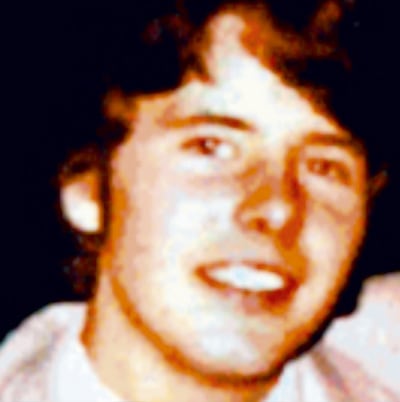
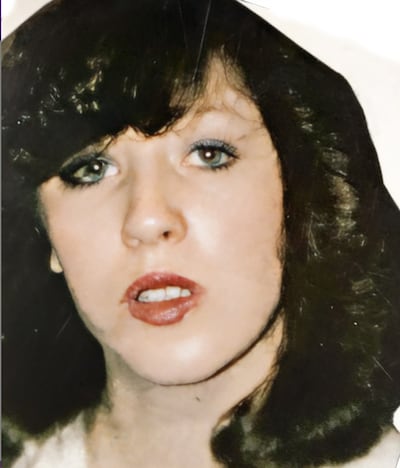
Among them were the Keegans: Christine and John, and their children John, Mary and Antoinette. They had been sharing one bedroom, living with extended family in Ballyfermot in 1964 when Martina was born. Christine Keegan told staff in the Coombe Hospital about their housing conditions.
“To our parents’ surprise, an inspector immediately called to our auntie’s house to do the inspection,” Antoinette’s sister Lorraine Keegan told the inquests. “In the following couple of days, our parents got our new three-bedroom family house in Coolock. Our parents were delighted and excited to bring their newborn baby Martina home to a brand-new house with lots of room for us all at last.”
Despite a bleak economy there were good local employers – Cadbury’s, Chivers and Scotts Foods. The younger people had jobs in Superquinn, RTV Rentals or other shops in the Northside Shopping Centre. It was an optimistic, forward-looking community of large, busy families. By 1981, their children were among the first to be old enough to go to nightclubs. They had a few bob in their pockets, friends and their whole lives ahead of them.
Among the first in the Stardust queue as the doors opened on February 13th, 1981, were Martina and Antoinette Keegan, and their friend Helen Henvey. Martina – bubbly and warm and known for her Marilyn Monroe looks – was looking forward to meeting her boyfriend, David Morton whom she had met in Superquinn where they both worked.
The girls’ handbags were searched on the way in. None was asked for proof of age. They paid the £3 entrance fee which included a meal. That night it was sausage and chips.
Once in, they met their older sister Mary Keegan and her friend Mary Kenny and took seats at a table three rows back in the north alcove. Normally this larger area was screened off and the smaller west alcove open, but with a big crowd expected that night the north alcove was open instead.
Michael Barrett, from Raheny, was in two minds about going. He had helped DJ at the Stardust for several months but there were frequent electrical glitches that irritated him. And his friend, Colm O’Brien (20) who drove the DJ van, was late. Heading out at about 8pm, his last words to his sister Carole (16), were: “If I’m not back you’ll know I got the lift.”
An apprentice plumber, his passions were Liverpool FC, Dublin GAA and DJing. An “absolute pet”, he was the oldest of Gertrude Barrett’s four children, and “very close” to his mother.


He was gentle, “always smiling” and set on becoming a professional DJ if the plumbing didn’t work out. Colm collected Michael and two other DJs and they arrived at the Stardust about 8.30pm. Colm reversed the van up to steps at the backstage door, known as exit three, as usual. They brought the gear in and were set up by 9.50pm.
The club opened at 10pm. By 11pm the queue stretched right down the front of the building. The last of the 846 patrons that night were admitted around midnight. Though it was an over-21s event, 83 per cent of those admitted were under 21 and 65 patrons were aged just 14, 15 or 16 years, the inquests heard.
The bars closed at 1am and the dance competition got under way at about 1.15am. A total of 36 people competed as Danny Hughes, the lead DJ, played Born To Be Alive, a six-minute track by Patrick Hernandez.
Patrons and staff crowded around the dance floor to watch, some standing on chairs and tables to get a better view. Hughes announced the two winners, Paula McDonnell and Errol Buckley, at about 1.30am and invited them backstage to get their certificates. The winners, both of whom would lose siblings, Julie McDonnell and Jimmy Buckley in the fire, came back on stage and danced for the crowd.
Colm O’Brien played Born To Be Alive again followed by Lorraine by Bad Manners and Shaddap You Face by Joe Dolce as patrons started to fill the dancefloor again. Others went to the toilets or back to their seats, some to the cloakroom to get their coats.
Around this time waitress Elizabeth Marley was collecting dirty plates. On her journey back to the kitchen, at about 1.30am when passing the west alcove, she got a heavy smell of smoke. Smoking was permitted in bars but this was different to cigarette smoke. She went straight to kitchen manager, her mother, Teresa Marley. They went back into the ballroom. Elizabeth Marley looked under the blinds and saw a small flame on seats at the back. This was coming up to 1.40am.
She ran to the main bar and shouted to barmen who were cleaning glasses and cashing up. One of them, Gerry Guilfoyle, grabbed a fire extinguisher. She went on into the Lantern Rooms, a separate function room, where an event for the Marine Port and General Workers’ Union was finishing. Doorman John Fitzsimons, who was also a DFB fireman, grabbed a fire extinguisher. The Lantern Rooms was evacuated.
Maria Brady, lounge girl supervisor, collecting glasses in the Stardust about the same time, saw a “glow” behind the blinds. She ran to the main bar and shouted to barman Larry Neville: “There’s a fire”.
Patron Jacqueline McCarthy was sitting with friends at a table by the west alcove when they noticed fire behind the blinds. She ran to the foyer and told doorman Patrick J Murphy. He came, raised one of the vertical blinds and ran for a fire extinguisher. The fire appeared to grow at this point.
Within eight minutes the entire ballroom would be engulfed in flames.
Another waitress, Elizabeth Prizeman, alerted deputy head doorman Leo Doyle in the foyer. The time now was 1.42am. Doyle ran with a fire extinguisher to the west alcove.
Neville, having come from the main bar and seen flames “about 3ft” high ran to the Silver Swan bar where Eamon Butterly was with other staff, and shouted: “There’s a fire in the Stardust”. Neville ran back to the ballroom where by now fire was “jumping” from row to row “like a fireball” across the seats. He ran to phone 999.
“Would you come down to the Stardust Club in Artane as fast as you can,” he said. “There is a large fire. There is over 800 people in the place. For God’s sake come quick, it is getting out of control.” The call was logged at 1.43am.
Also at 1.43am, doorman Fitzsimons called Tara Street control where his Dublin Fire Brigade colleague, fire officer Dermott Dowdall, took the call.
“[He said] there was over 800 people in the building and that it would be hard to get them all out,” Dowdall told the inquests, adding that Fitzsimons said: “I am giving you a district call”. A district call in 1981 indicated a fire posing serious threat to life. “I started to tell a sub-officer, and I heard John Fitzsimons on the phone again saying, ‘I can’t stay. We could lose 200 people here. Send loads of ambulances,’.”
Staff including head of security Doyle, foyer doorman Murphy and barmen Guilfoyle and Colm O’Toole were now attempting to put out the fire. As the polyurethane foam of the seats melted it pooled into liquid polyurethane, and the squirting from extinguishers spread the fire, the inquests heard.
Dr Will Hutchinson, forensic scientist and fire investigator, set out to the inquests what ensued once the fire was first seen in the west alcove on seats abutting the carpeted wall.
As flame heated them these tiles became more flammable and ignited. Lower tiles, once ignited, heated those above and flame started “licking” up the walls.
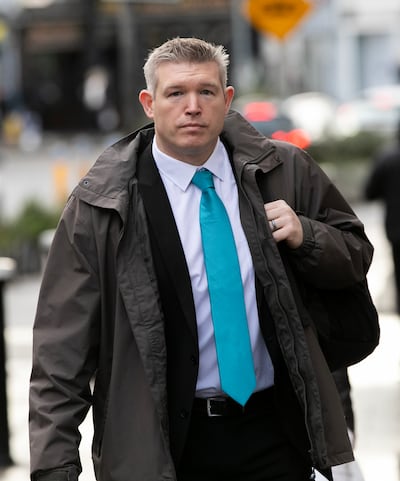
These and the polyurethane foam in the seats began emitting highly flammable gases – carbon monoxide and hydrogen cyanide. The suspended ceiling-tiles were not flammable but the ceiling itself was below minimum permitted height in the west alcove. The noxious, flammable gas layer rose quickly reaching the ceiling and then building rapidly downwards. As more and more seats heated and emitted flammable gases, and temperatures increased rapidly to well more than 550 degrees, the seats began to self-ignite, said Dr Hutchinson.
Above the ceiling, polystyrene insulation around heating ducts was igniting and melting, in turn causing rigid polystyrene ceiling-grilles and PVC-coated ducts to melt, ignite and form flaming droplets. At this stage, said doorman Murphy, “the ceiling started to drip, melt”.
Within two minutes of the fire starting all combustible material in the west alcove was involved in the conflagration, producing large amounts of black toxic smoke, Hutchinson told the inquests. Air temperature 1cm below the suspended ceiling was 1,200 degrees “in less than two minutes . . . death would have been very swift” for anyone present, he said.
A series of events followed in rapid succession, in seconds: a portion of the ceiling over the west alcove collapsed, sending thick plumes of black, toxic smoke over the dance floor, making it hard to breathe and see. The ballroom lights flashed bright momentarily, then failed as flame shot across the entire ballroom ceiling, “whoosh, like petrol has been thrown on it”, said one witness, in a phenomenon known as “flash-over”. It was now 1.45am. With smoke and flame filling the ballroom, conditions in the venue were “untenable after 52 seconds”, fire expert Martin Davidson told the inquests.
Outside the venue, in houses around Maryfield Crescent and Drive, residents were seeing flames “powering” through the roof of the Stardust as early as 1.40am, indicating the fire was already well established in the roof-space when it was first seen as a small flame inside the venue.
The dancefloor was full when the DJ, Colm O’Brien, saw a “small fire” he thought “was going to be controlled”. Instinctively, he made an announcement urging people not to panic and continued playing music. Within seconds, however, as the ceiling caught fire, he made a further announcement, advising people to move calmly to the exits.
There were six emergency exits from the ballroom: exit one was reached from the dancefloor by steps up the left of the north alcove and down a passageway at the back of the seats. Exit two was the main exit through the foyer. Exit three was reached from the backstage area. Exits four and five went directly out from the dancefloor, and exit six was reached down stairs from along the right side of the north alcove.
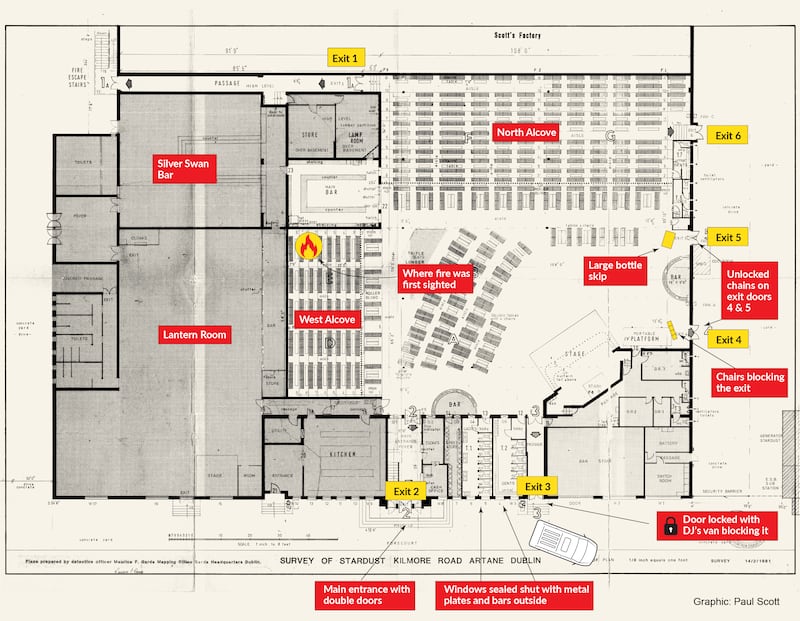
Exit one appears to have worked well, having been opened by head doorman Thomas Kennan when the alarm was raised.
The majority of patrons, however, made a rush to the main entrance – exit two. Doorman Frankie Downes said he opened both of the double doors at the main exit when he saw smoke. Seconds later there was a rush of people, the lights went out and there was “complete panic”, he said. One of the doors appears to have shut over for a time.
“The doors were locked and nobody could go anywhere,” said Paul Fitzmaurice, who was age 16 at the time. He went upstairs to the first landing, turned and saw “orange flames coming down towards me . . . I had my hands up over my face to protect my face. I fell down the stairs, I was trampled on and by the time I got to my feet . . . it seemed the doors [had been] opened and I was kind of carried out by the force of people.”
Anthony Preston, age 24 at the time, said they were trapped “like cattle” in the foyer. “I tried to make my way up the stairs, feel my way up the stairs. You only had one intake of breath. I had to hold it until I got up those steps to get air. I just wanted to get air. On the stairs there was people giving up. They were all on the stairs, giving up. The fumes. They were dying before the fire got to you.”
As oxygen levels fell and carbon monoxide and hydrogen cyanide increased, people’s consciousness and decision-making capacities decreased. “Everyone will have experienced [falling oxygen levels],” forensic pathologist Dr Richard Shepherd told the inquests.
“Consciousness is going to be lost . . . the ability to make decisions, the ability to strive to escape – all of these things will decline as the toxic gases and the lack of oxygen have their effect on the body. Time is crucial,” he said. “Any obstruction, any slowing down in the exit . . . to safe air is going to cause great problems.”
Most of those who died, he added, would have lost consciousness before they were affected by extreme heat.
At exit three, people encountered a lock and chain and had to break the door open, and then the DJ van was obstructing the exit. Trevor King, age 17 at the time, described “a crush” and “people kicking” at exit three. There were “about 10 to 15 fellas ahead of me. I heard one of them saying, ‘Jesus Christ, the doors are locked’. Some . . . ran at the door and kicked at it. Most of the crowd ran at the door a couple of times and then the door opened.”
Within a minute of O’Brien first seeing fire, the west alcove “was ablaze. I was still on the stage . . . People in front of the stage panicked and ran on to the stage . . . Girls were grabbing, asking for the way out.” He saw Michael Barrett on the stage, to the left. It is the last sighting of Michael alive.
O’Brien was pushed with others downstairs into the backstage area and into a toilet. “I stayed there for about half a minute . . . The smoke then started coming in under the door and I could hear the fire crackling outside.” He stood on the toilet and “tried to push through the ceiling”. Unable to, he wrapped his jumper over his face and in darkness felt his way along walls towards exit three where he got out.
The bodies of 22 people were found in a curve around exits four and five – metres from safety. Obstacles here included chairs and a portable platform stacked at exit four, a large bottle skip at exit five, and chains draped over panic bars.
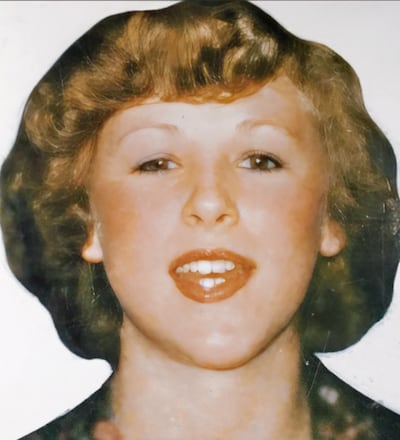
Martina Keegan was holding Antoinette’s left hand as they tried to get to exit four, which was blocked, and then to exit five. “We were about 6ft from the door and the panic of people all trying to get out,” recalled Antoinette. “We were all pushed to the floor and we couldn’t get back up as people trampled over us to make their escape. I remember looking up and seeing that people couldn’t open the doors and the heat was getting so intense.
“I remember a ball of flame coming towards us and I put my hands over my head the heat of the fire was so hot, and the thick black smoke, we couldn’t breathe. I thought, ‘This is it, we are dead’. I saw a person . . . in a ball of flames under the table and they just kept rolling over screaming. After that I just remember my last words: ‘Oh God please help us’. After that I was unconscious.”
Thomas Larkin, age 26 at the time, got out through exit four or five just ahead of the Keegan girls. He described a crowd “of about 20 or 30 people trying to push the door open”. He was pulled out. He heard screaming and went back in about six or seven feet.
“I spotted the silk white blouse . . . I tried to pull her out but I couldn’t pull her because she was holding on to something. The only way I could get her to release her hand was to kick her hand, to release whatever she was holding on to, because whatever she was holding she was holding on tight.” He had pulled Antoinette Keegan free, having kicked her hand from its grasp of Martina’s, whom he could not save.
Deborah Osbourne, then age 19, was holding hands with Sandra Lawless and Paula Lewis who both perished. They let go of each other as heat intensified, near exit five. “The pain of the heat you couldn’t explain to anybody and the fear. I remember thinking, ‘Please let me see the sky. Please let me see my mother and father, please’. The fear never left me but the pain – after a while you don’t feel the pain. The pain just goes away.”
Setting out at the inquest what happened before she got out of the nightclub, she said she and Sandra “were hugging each other. I had her face in my hands and her face was red and she said, ‘Deborah we are going to die’. And I says, ‘No, we’re not Sandra’, and the two of us lay down. And at that stage, it’s very hard to explain, you are still scared but you don’t feel anything . . . It’s like you’re going somewhere nice. I was just going somewhere nice. You’re going toward something. It’s there and you’re just reaching to get to that place. We were happy to find each other. We wanted to go to sleep. That’s the way it felt.”
She got out through exit five, having been kicked awake by a friend, but without Sandra. “I am glad I saw her before she died. We were happy we found each other in that moment,” she told the inquests.
Exit six appears to have worked well, but few patrons knew it existed.
Many ended up in the toilets. These filled quickly with smoke as windows were blocked. The inquests heard harrowing accounts of people outside, including firemen using steel ropes attached to fire appliances, making futile attempts to break through to rescue people screaming and banging inside.
Eamon Butterly, through eight days in the witness box, said he was “devastated” by graphic accounts of panic and chaos at exits. He had believed the Stardust was “one of the safest places around”.
He agreed some of his decisions, such as ordering exits to be locked until midnight, were “wrong” and that management on the night was “not fit for purpose”. But to the end he insisted, when the fire broke out all exits were unlocked. He knew this, he said, because his uncle and head of security, the late Thomas Kennan, “told me the doors were open”. His credibility, said Michael O’Higgins SC for families of 10 of the dead, was ”shredded beyond redemption”.
His assertions contrasted with the preponderance of testimony from witnesses, including his former deputy head doorman, Leo Doyle, who told the inquests he believed: “The doors were locked. They must have been.”
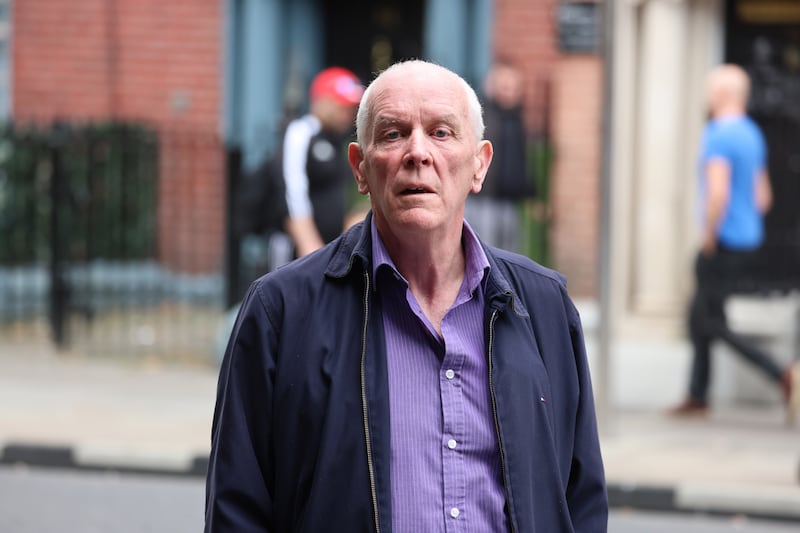
The six exits, if they had worked as they should, would have been adequate for all 850-plus people to get out, fire expert Davidson said. The “tragedy”, however, was that these were “rendered redundant by the rapid fire growth, primarily caused by the carpet tiles on the wall”.
The first Dublin Fire Brigade engine, FB61, was on the scene, at 1.49am, six minutes after the first 999 call. It had come from Kilbarrack. Two minutes into their journey the crew could see flames and smoke in the night sky ahead, indicating the fire had already vented the roof. The second tender, FB42, from North Strand, arrived at 1.50am. Four more tenders would arrive – two from North Strand and two from Tara Street – by 1.58am.
The scene coming on to the site was chaotic. With no member of Stardust management taking control, firefighters were “hugely dependent” on gardaí to control the crowds, coroner Dr Myra Cullinane heard. They described teenagers with burn injuries crying, screaming, some of them inebriated, in shock, stopping the tenders “desperate” for help. People, trying to get back in to find loved ones, had to be physically restrained.
With the fire already past its peak, the first tasks were to dampen it right down and get in to rescue those in the toilets.
Patrick Hobbs, then a 36-year-old acting fire officer in Tara Street, donned breathing apparatus and got to the gent’s toilets near the front. “I saw about five people . . . huddled together. One fellah was in a collapsed condition on his own in the urinal . . . Some of the others came towards me. They were all overcome by smoke.” He and colleagues got all five out. Two young men and a young woman were rescued from the ladies’.
With the toilets evacuated, firemen began a “gruesome” systematic search of the smoldering building. The inquests heard distressing descriptions of bodies so burnt they could not be recognised as male or female, and bodies entwined around each other, some apparently holding hands or in embraces.
“They were caught out by the speed of the events,” said fire officer Dowdall at the inquests. “The sheer reaction was defensive, that they grabbed one another, got their heads down and [would] not know too much after that.”
Where remains were so entangled in fallen debris and metal, stretchers could not get to them. “We just had the stretchers in the aisles. We used carrying sheets in between because you couldn’t get the stretchers in. They’d get tangled in the wires. We removed the wire and took the bodies out and then on to the stretchers and took them outside,” recalled fire officer Brian Parkes.
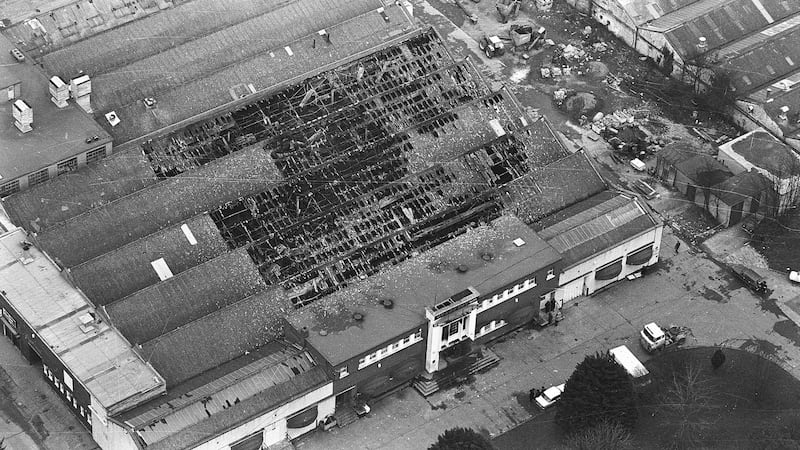
By the end 40 bodies were removed and lined up on a verge outside, before removal by ambulance to the city morgue in Store Street. Four victims were pronounced dead later that morning following attempts at resuscitation in hospital, with four more dying between four and 25 days later in hospital.
Several emergency services personnel became visibly upset at the inquests as they recalled the events of that night. Noel Keegan, a 30-year-old officer based in Tara Street in 1981, removed people from toilets and still does not know whether they survived. He carried bodies “burnt to a cinder” and “still on fire” from the scene.
In a note he had intended to read at the inquests, but became too upset to do so, he said: “I often wondered what type of person I would have been had I not experienced that night – what kind of husband, father, son, brother and friend I might have been.”
The “unbearably distressing” process of identifying their children’s remains faced parents from the afternoon of that Saturday, February 14th. Most were identified through fragments of clothing and jewellery, or dental or medical records.
The impact on families and their communities was devastating.
Alison Croker, in one of 48 moving pen-portraits read by families and friends describing their loved ones at the start of the inquests, described the funeral of her sister Jacqueline.
“There were four coffins laid out in the church. One was that of Julie McDonnell, who was my football coach. One was of Caroline Carey, who I knew from Irish dancing. One was Michael Griffiths, who I knew through Jackie, and one was our Jackie. Everyone knew everyone in our community . . . each loss was felt by the community as well as the families. Living at home after the Stardust fire, you wouldn’t be able to get on to a bus without seeing someone either with visible scarring . . . or someone known to you who had lost someone in the fire.”
She continued: “Nobody ever spoke about it with each other in the community because you would have no idea how the other person would react to something so emotional and affecting. It felt like everybody was left on their own.”
As the families began their saddest journeys, rumour began to swirl. Were the exits locked? How could the fire have spread so fast? How did it start?
The following Wednesday, February 18th, 1981, Haughey announced the tribunal of inquiry into the fire, chaired by Mr Justice Keane. It began hearing evidence, at Blackhall Place, on April 6th, 1981. It sat for 122 days, heard from 363 witnesses, cost more than £1 million and concluded on November 26th.
In March 1982, 48 inquests were heard. They lasted about 15 minutes each with verdicts providing just medical causes of death.
Publication of the 673-page Keane tribunal report in June 1982 brought little relief to the families. Despite finding “no evidence to indicate that the fire was . . . started deliberately”, it concluded: “The more probable explanation of the fire is that it was caused deliberately” in the west alcove.
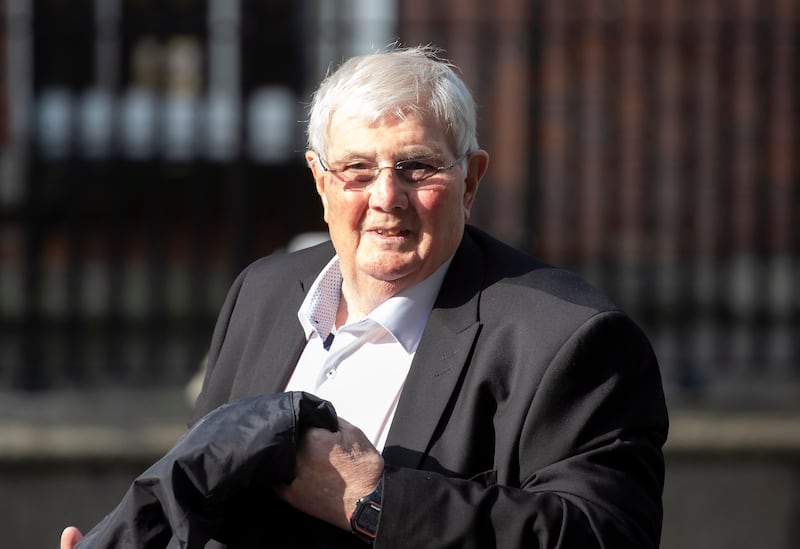
The finding allowed Scotts Food Ltd, owner of the Stardust, to claim £581,496 compensation from Dublin Corporation for malicious damage in 1983.
Two years later, four years since the blaze, none of the severely injured or grieving families had received a penny in compensation. Civil proceedings were initiated, including 290 cases against the State, but by May 1985 just one had been set down for trial. The then leader of the opposition, Charles Haughey, said in the Dáil in June 1985, it was “horrifying” that “the debt owed by society to victims” had not yet been paid. A victims’ compensation tribunal was established in September 1985. Up to £10.4 million was eventually paid, by the State, to more than 800 claimants.
Still the arson finding besmirched the memories of the young victims, said the families. A handful – notably the Barrett, Keegan, Kiernan, Hobbs and Hogan families – campaigned over two decades to have this overturned. In 2008 Paul Coffey SC (now a High Court judge) was appointed by government to review the case for a new inquiry. His 2009 report did not recommend reopening an investigation but said the finding that arson caused the inferno should be removed from the public record, which it was by the Oireachtas that year.
With now no official explanation as to the cause of the fire, families continued to seek answers. They gathered evidence they said pointed to the fire having started in the roof space, rather than in the west alcove.
The inquests heard fire investigator Hutchinson say earlier this year “a likely” scenario was that the fire started in a badly-wired hot-press in the main bar adjacent to the west alcove. Photographs taken after the blaze showed signs of an electrical fault that could have caused localised heating, which could have ignited the PVC coating on the lagging jacket.
“Fire would channel upwards like a chimney into the ceiling void,” he said. Here, there was fuel including polystyrene insulation which could ignite and melt plastic ceiling grills. Flaming droplets would drip through gaps in the ceiling tiles, including on to seats in the west alcove. This could explain why neighbours saw fire powering through the Stardust roof before a small flame was seen on a seat inside the venue, he agreed.
Retired judge Patrick McCartan, appointed by cabinet in March 2017 to examine the families’ case for a new inquiry, rejected it later that year.
Weeks later, Gertrude Barrett contacted then Dublin MEP Lynn Boylan, asking whether taking the campaign to Europe could help. Boylan brought families to address MEPs in Strasbourg, and also later invited Belfast-based solicitor Darragh Mackin, to meet them.
In early 2018 he met Antoinette Keegan and June McDermott, who each lost siblings. In April 2018, at a press conference in Dublin and accompanied by now more families, Mackin confirmed he had formally notified the attorney general Woulfe, of their intention to apply for fresh inquests under section 24 of the Coroners Act, 1962. The original inquests “cannot be considered to have been an effective or adequate mechanism for the purposes of investigating how the deaths came about”, said Mackin. The families would invoke the European Convention on Human Rights, article two, he said.
In an article two inquest, he explained, not only must the “when”, “where” and “how” a person died be inquired into, but also the circumstances in which they died.
In September 2019, Woulfe agreed, directing fresh inquests be held. There had been “no reference to the surrounding circumstances” of the deaths, “in particular the cause or causes of the fire . . . at the original inquests”, he said. There was both “the entitlement of the families of the victims to the public revelation of the facts” and also “a distinct and separate imperative that the community as a whole should be satisfied . . . that there be sufficient inquiry at any inquest . . . to maximise the chances that the truth should emerge”.
While Coffey and McCartan were reviews of evidence, these inquests would look at the evidence afresh, as if for the first time. New evidence would emerge and previously-heard evidence would be examined through the prism of the European Convention on Human Rights. Dr Cullinane, on a number of occasions during the inquests reiterated, the lives of the 48 would be “vindicated” in her court.
On April 25th, 2023, fresh inquests into the deaths of 48 children and young people, in a fire in a ballroom 42 years previously, began as Gertrude Barrett (86) read into the record her pen portrait of her boy, Michael, last seen on the left side of the stage.













